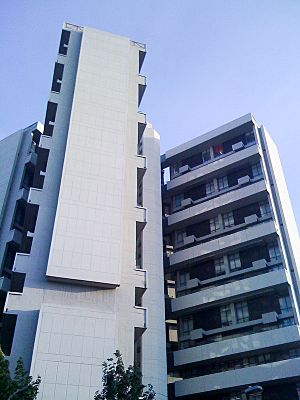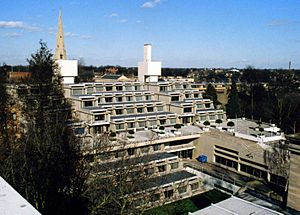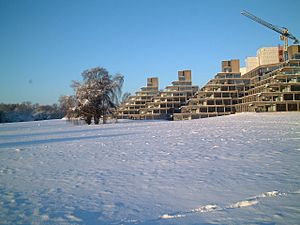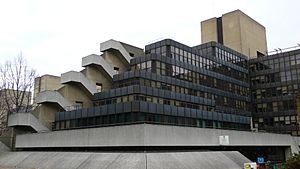Denys Lasdun facts for kids
Sir Denys Louis Lasdun (born September 8, 1914, died January 11, 2001) was a famous English architect. He designed many important buildings. His most well-known work is the Royal National Theatre in London. This building is on the South Bank of the River Thames. It is a special example of Brutalist architecture, known for its strong, concrete look. Denys Lasdun studied architecture in London. He was inspired by other famous architects like Le Corbusier. He also learned from older styles, like those of Nicholas Hawksmoor.
Contents
Lasdun's Family Life
Denys Lasdun came from a talented family. His grandfather, Louis Abrahams, was an art collector in Australia. He supported many artists from the Heidelberg School, which was an Australian art movement. Denys inherited some of his grandfather's art.
His mother, Julie Lasdun, was a talented pianist. She played with famous musicians. The Royal College of Music even created a special award, the Julie Lasdun Prize, in her honor.
In 1954, Denys Lasdun married Susan Bendit. They had two sons and one daughter. One of their sons, James Lasdun, became a writer.
Early Buildings and Ideas

Before and after World War II, Lasdun worked with other architects. He helped design the Hallfield Estate in London. His design for Hallfield School showed his own unique style. It used bare concrete and sharp angles.
In the 1950s, Lasdun became known for his "cluster blocks" in Bethnal Green. These buildings were designed to help people feel more connected. Instead of separate flats, they grouped homes around a central tower. This way, people could easily see their own flat and feel part of a community. An example is Keeling House, which was later turned into luxury flats.
The Royal College of Physicians

One of Lasdun's most important early works is the Royal College of Physicians building (1964). It is located in Regent's Park in London. This building is very modern, with concrete and open spaces. It looks like parts of the building are floating!
The Royal College of Physicians building uses fancy materials. These include white marble, glass tiles, and polished brass. It was one of the first buildings after World War II to be given a special "Grade I" listing. This means it is very important and has influenced other architects.
Designing for Universities
Lasdun also designed many buildings for universities. His style, with its blocky shapes and concrete, was seen in his work for Fitzwilliam College, Cambridge.
He designed a large part of the University of East Anglia. This included classrooms, labs, and student housing. The student homes were shaped like ziggurats, which are ancient stepped pyramids.
Later, he designed buildings for the University of London. These included parts of SOAS and the Institute of Education. These buildings also used his Brutalist style. They created new public spaces for students.
Later Works and Awards
Lasdun's most famous building is the Royal National Theatre on London's South Bank. Some people, like Prince Charles, thought it looked like a power station. But others, like John Betjeman, loved its design. Lasdun also designed the nearby IBM headquarters.
His last work in London was an office building called Milton Gate. This building used green-tinted glass. This was a change from his usual concrete style.
In 1977, Denys Lasdun received the RIBA Royal Gold Medal. This is a very high honor for an architect. Many of his buildings are now protected because they are so important.
Denys Lasdun died on January 11, 2001, when he was 86 years old.
Key Projects

- Hallfield Primary School, London (1952)
- Keeling House, Bethnal Green, London (1957)
- 26 St James's Place, London (1959–60)
- Fitzwilliam College, Cambridge (1959–63)
- Royal College of Physicians, London (1960–64)
- Core buildings of the University of East Anglia, Norwich (1962–68)
- University Sports Centre, Liverpool (1963)
- The Charles Wilson building at the University of Leicester
- The Lasdun Building, a residential block at the University of Leicester
- Institute of Advanced Legal Studies, Institute of Education, and the library of the School of Oriental and African Studies, London
- New Court, Christ's College, Cambridge (1966–70)
- Royal National Theatre, South Bank, London (1967–76)
- First phase of the European Investment Bank, Luxembourg (1974–80)
- IBM Building, South Bank, London (1979–83)
See also
 In Spanish: Denys Lasdun para niños
In Spanish: Denys Lasdun para niños




